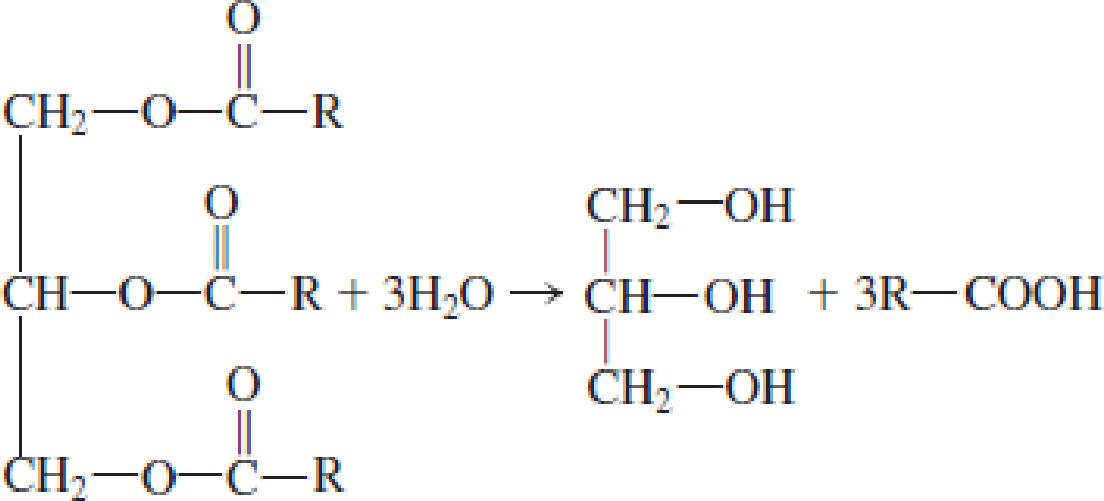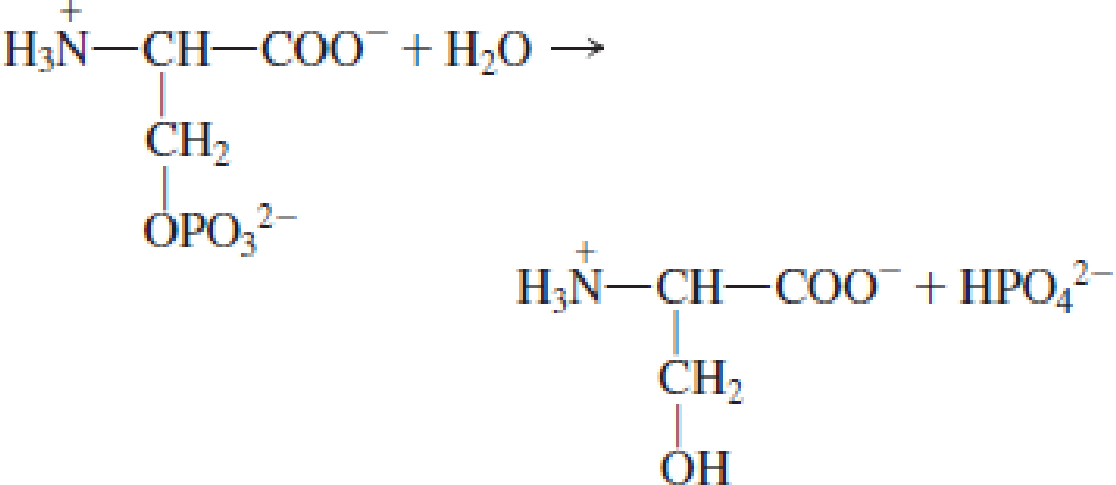
General, Organic, and Biological Chemistry
7th Edition
ISBN: 9781285853918
Author: H. Stephen Stoker
Publisher: Cengage Learning
expand_more
expand_more
format_list_bulleted
Concept explainers
Textbook Question
Chapter 21, Problem 21.23EP
Identify the enzyme needed in each of the following reactions as an isomerase, a decarboxylase, a dehydrogenase, a lipase, or a phosphatase.




Expert Solution & Answer
Want to see the full answer?
Check out a sample textbook solution
Students have asked these similar questions
can someone answer the questions and draw out the complete mechanism
Please help, draw and me the proper mechanisms.
Please help on part 2 not part 3. Please write in the proper reagents
Chapter 21 Solutions
General, Organic, and Biological Chemistry
Ch. 21.1 - Which of the following statements concerning the...Ch. 21.1 - Prob. 2QQCh. 21.2 - Which of the following statements about a...Ch. 21.2 - Which of the following statements about cofactors...Ch. 21.2 - Prob. 3QQCh. 21.3 - Which of the following statements concerning an...Ch. 21.3 - Prob. 2QQCh. 21.3 - Which of the following pairings of enzyme type and...Ch. 21.3 - Which of the following pairings of enzyme type and...Ch. 21.4 - Prob. 1QQ
Ch. 21.4 - Which of the following statements concerning the...Ch. 21.4 - Prob. 3QQCh. 21.5 - The specificity of an enzyme that catalyzes the...Ch. 21.5 - Prob. 2QQCh. 21.6 - The number of substrate molecules converted to...Ch. 21.6 - Prob. 2QQCh. 21.6 - Prob. 3QQCh. 21.7 - Extremozyme presence is not possible in which of...Ch. 21.7 - Prob. 2QQCh. 21.8 - Prob. 1QQCh. 21.8 - Prob. 2QQCh. 21.8 - Prob. 3QQCh. 21.9 - Prob. 1QQCh. 21.9 - Prob. 2QQCh. 21.9 - Prob. 3QQCh. 21.10 - Prob. 1QQCh. 21.10 - Prob. 2QQCh. 21.11 - Prob. 1QQCh. 21.11 - Prob. 2QQCh. 21.12 - Prob. 1QQCh. 21.12 - Prob. 2QQCh. 21.12 - Prob. 3QQCh. 21.13 - Prob. 1QQCh. 21.13 - Prob. 2QQCh. 21.13 - In the recharging of a metal-containing enzyme by...Ch. 21.14 - Prob. 1QQCh. 21.14 - Prob. 2QQCh. 21.14 - Prob. 3QQCh. 21.14 - Which of the B vitamins has a name that draws...Ch. 21.14 - Prob. 5QQCh. 21.14 - Prob. 6QQCh. 21.15 - Prob. 1QQCh. 21.15 - Prob. 2QQCh. 21.15 - Prob. 3QQCh. 21.15 - For which of the following vitamins is blood...Ch. 21.15 - Prob. 5QQCh. 21 - What is the general role of enzymes in the human...Ch. 21 - Why does the body need so many different enzymes?Ch. 21 - Prob. 21.3EPCh. 21 - Prob. 21.4EPCh. 21 - Indicate whether each of the following phrases...Ch. 21 - Indicate whether each of the following phrases...Ch. 21 - Explain why a metal ion can function as a cofactor...Ch. 21 - Prob. 21.8EPCh. 21 - Prob. 21.9EPCh. 21 - Indicate whether each of the following statements...Ch. 21 - Prob. 21.11EPCh. 21 - Based on its name, indicate whether each of the...Ch. 21 - Predict the function of each of the following...Ch. 21 - Predict the function of each of the following...Ch. 21 - Prob. 21.15EPCh. 21 - Prob. 21.16EPCh. 21 - Prob. 21.17EPCh. 21 - Suggest a name for an enzyme that catalyzes each...Ch. 21 - Prob. 21.19EPCh. 21 - Prob. 21.20EPCh. 21 - To which of the six major classes of enzymes does...Ch. 21 - To which of the six major classes of enzymes does...Ch. 21 - Identify the enzyme needed in each of the...Ch. 21 - Identify the enzyme needed in each of the...Ch. 21 - Prob. 21.25EPCh. 21 - Indicate whether each of the following statements...Ch. 21 - Indicate whether each of the statements in Problem...Ch. 21 - Indicate whether each of the statements in Problem...Ch. 21 - Prob. 21.29EPCh. 21 - Prob. 21.30EPCh. 21 - Prob. 21.31EPCh. 21 - Prob. 21.32EPCh. 21 - Indicate whether each of the following statements...Ch. 21 - Indicate whether each of the following statements...Ch. 21 - Prob. 21.35EPCh. 21 - Prob. 21.36EPCh. 21 - Prob. 21.37EPCh. 21 - Prob. 21.38EPCh. 21 - What type of specificity (absolute, group,...Ch. 21 - What type of specificity (absolute, group,...Ch. 21 - The following graph shows the relationship between...Ch. 21 - Based on the graphical information in Problem...Ch. 21 - Prob. 21.43EPCh. 21 - Based on the graphical information in Problem...Ch. 21 - Prob. 21.45EPCh. 21 - Prob. 21.46EPCh. 21 - Draw a graph that shows the effect of increasing...Ch. 21 - Prob. 21.48EPCh. 21 - Prob. 21.49EPCh. 21 - What is an enzyme turnover number?Ch. 21 - Describe the effect that each of the following...Ch. 21 - Describe the effect that each of the following...Ch. 21 - What is an extremophile?Ch. 21 - What are two common environmental settings where...Ch. 21 - Indicate whether each of the following pairings of...Ch. 21 - Indicate whether each of the following pairings of...Ch. 21 - Prob. 21.57EPCh. 21 - What type(s) of extremophiles are used in oil well...Ch. 21 - Prob. 21.59EPCh. 21 - Prob. 21.60EPCh. 21 - Prob. 21.61EPCh. 21 - Indicate whether each of the following statements...Ch. 21 - Prob. 21.63EPCh. 21 - Indicate whether each of the following statements...Ch. 21 - Prob. 21.65EPCh. 21 - Indicate whether each of the following statements...Ch. 21 - Prob. 21.67EPCh. 21 - Prob. 21.68EPCh. 21 - Prob. 21.69EPCh. 21 - Prob. 21.70EPCh. 21 - Prob. 21.71EPCh. 21 - Prob. 21.72EPCh. 21 - Prob. 21.73EPCh. 21 - Prob. 21.74EPCh. 21 - Prob. 21.75EPCh. 21 - Prob. 21.76EPCh. 21 - Prob. 21.77EPCh. 21 - Prob. 21.78EPCh. 21 - Prob. 21.79EPCh. 21 - Prob. 21.80EPCh. 21 - Prob. 21.81EPCh. 21 - Prob. 21.82EPCh. 21 - What is the medical diagnostic value associated...Ch. 21 - Prob. 21.84EPCh. 21 - Indicate whether each of the following is a...Ch. 21 - Indicate whether each of the following is a...Ch. 21 - Prob. 21.87EPCh. 21 - Prob. 21.88EPCh. 21 - Prob. 21.89EPCh. 21 - Prob. 21.90EPCh. 21 - Prob. 21.91EPCh. 21 - What are the structural differences between the...Ch. 21 - Prob. 21.93EPCh. 21 - Prob. 21.94EPCh. 21 - Vitamin C is biosynthesized in a two-step process....Ch. 21 - Prob. 21.96EPCh. 21 - Prob. 21.97EPCh. 21 - Prob. 21.98EPCh. 21 - Prob. 21.99EPCh. 21 - Prob. 21.100EPCh. 21 - Which of the B vitamins has a structure that fits...Ch. 21 - Which of the B vitamins has a structure that fits...Ch. 21 - Prob. 21.103EPCh. 21 - Prob. 21.104EPCh. 21 - Prob. 21.105EPCh. 21 - Prob. 21.106EPCh. 21 - The coenzyme forms of B vitamins are involved in...Ch. 21 - The coenzyme form of B vitamins are involved in...Ch. 21 - Prob. 21.109EPCh. 21 - What is the relationship between the plant pigment...Ch. 21 - Prob. 21.111EPCh. 21 - List four major functions of vitamin A in the...Ch. 21 - Prob. 21.113EPCh. 21 - Prob. 21.114EPCh. 21 - Prob. 21.115EPCh. 21 - Prob. 21.116EPCh. 21 - Prob. 21.117EPCh. 21 - Prob. 21.118EPCh. 21 - Prob. 21.119EPCh. 21 - Prob. 21.120EPCh. 21 - Which structural form of vitamin E exhibits the...Ch. 21 - Prob. 21.122EPCh. 21 - Prob. 21.123EPCh. 21 - Prob. 21.124EPCh. 21 - Prob. 21.125EPCh. 21 - Prob. 21.126EPCh. 21 - Prob. 21.127EPCh. 21 - Prob. 21.128EPCh. 21 - Prob. 21.129EPCh. 21 - Prob. 21.130EPCh. 21 - Prob. 21.131EPCh. 21 - Which vitamin or vitamins has (have) each of the...Ch. 21 - Which of the 13 vitamins has a structure that fits...Ch. 21 - Prob. 21.134EP
Additional Science Textbook Solutions
Find more solutions based on key concepts
Single penny tossed 20 times and counting heads and tails: Probability (prediction): _______/20 heads ________/...
Laboratory Manual For Human Anatomy & Physiology
Identify each of the following reproductive barriers as prezygotic or postzygotic. a. One lilac species lives o...
Campbell Essential Biology with Physiology (5th Edition)
How could you separate a mixture of the following compounds? The reagents available to you are water, either, 1...
Organic Chemistry (8th Edition)
Separate the list P,F,V,,T,a,m,L,t, and V into intensive properties, extensive properties, and nonproperties.
Fundamentals Of Thermodynamics
What were the major microbiological interests of Martinus Beijerinck and Sergei Winogradsky? It can be said tha...
Brock Biology of Microorganisms (15th Edition)
45. Calculate the mass of nitrogen dissolved at room temperature in an 80.0-L home aquarium. Assume a total pre...
Chemistry: Structure and Properties (2nd Edition)
Knowledge Booster
Learn more about
Need a deep-dive on the concept behind this application? Look no further. Learn more about this topic, chemistry and related others by exploring similar questions and additional content below.Similar questions
arrow_back_ios
SEE MORE QUESTIONS
arrow_forward_ios
Recommended textbooks for you
 General, Organic, and Biological ChemistryChemistryISBN:9781285853918Author:H. Stephen StokerPublisher:Cengage Learning
General, Organic, and Biological ChemistryChemistryISBN:9781285853918Author:H. Stephen StokerPublisher:Cengage Learning Organic And Biological ChemistryChemistryISBN:9781305081079Author:STOKER, H. Stephen (howard Stephen)Publisher:Cengage Learning,
Organic And Biological ChemistryChemistryISBN:9781305081079Author:STOKER, H. Stephen (howard Stephen)Publisher:Cengage Learning, World of Chemistry, 3rd editionChemistryISBN:9781133109655Author:Steven S. Zumdahl, Susan L. Zumdahl, Donald J. DeCostePublisher:Brooks / Cole / Cengage Learning
World of Chemistry, 3rd editionChemistryISBN:9781133109655Author:Steven S. Zumdahl, Susan L. Zumdahl, Donald J. DeCostePublisher:Brooks / Cole / Cengage Learning World of ChemistryChemistryISBN:9780618562763Author:Steven S. ZumdahlPublisher:Houghton Mifflin College Div
World of ChemistryChemistryISBN:9780618562763Author:Steven S. ZumdahlPublisher:Houghton Mifflin College Div Chemistry for Today: General, Organic, and Bioche...ChemistryISBN:9781305960060Author:Spencer L. Seager, Michael R. Slabaugh, Maren S. HansenPublisher:Cengage Learning
Chemistry for Today: General, Organic, and Bioche...ChemistryISBN:9781305960060Author:Spencer L. Seager, Michael R. Slabaugh, Maren S. HansenPublisher:Cengage Learning

General, Organic, and Biological Chemistry
Chemistry
ISBN:9781285853918
Author:H. Stephen Stoker
Publisher:Cengage Learning

Organic And Biological Chemistry
Chemistry
ISBN:9781305081079
Author:STOKER, H. Stephen (howard Stephen)
Publisher:Cengage Learning,

World of Chemistry, 3rd edition
Chemistry
ISBN:9781133109655
Author:Steven S. Zumdahl, Susan L. Zumdahl, Donald J. DeCoste
Publisher:Brooks / Cole / Cengage Learning

World of Chemistry
Chemistry
ISBN:9780618562763
Author:Steven S. Zumdahl
Publisher:Houghton Mifflin College Div

Chemistry for Today: General, Organic, and Bioche...
Chemistry
ISBN:9781305960060
Author:Spencer L. Seager, Michael R. Slabaugh, Maren S. Hansen
Publisher:Cengage Learning

DIGESTER-35 | VITAMINS AND THEIR RELATED COENZYMES| GPAT | NIPER | PHARMACIST| DI; Author: GPAT DISCUSSION CENTER;https://www.youtube.com/watch?v=CGrdNYmho0s;License: Standard YouTube License, CC-BY